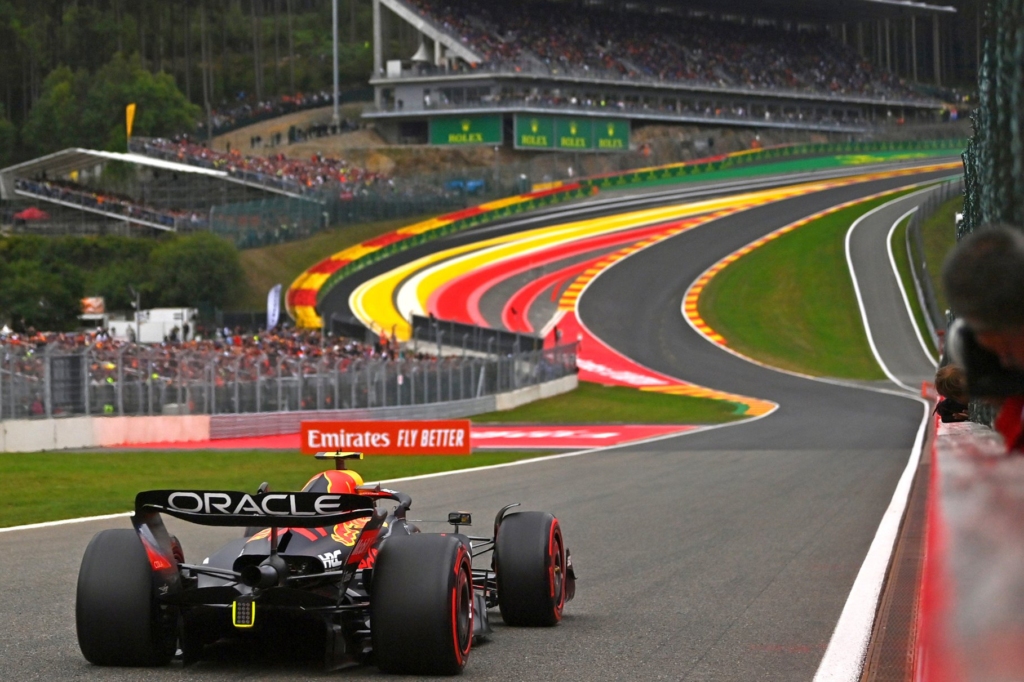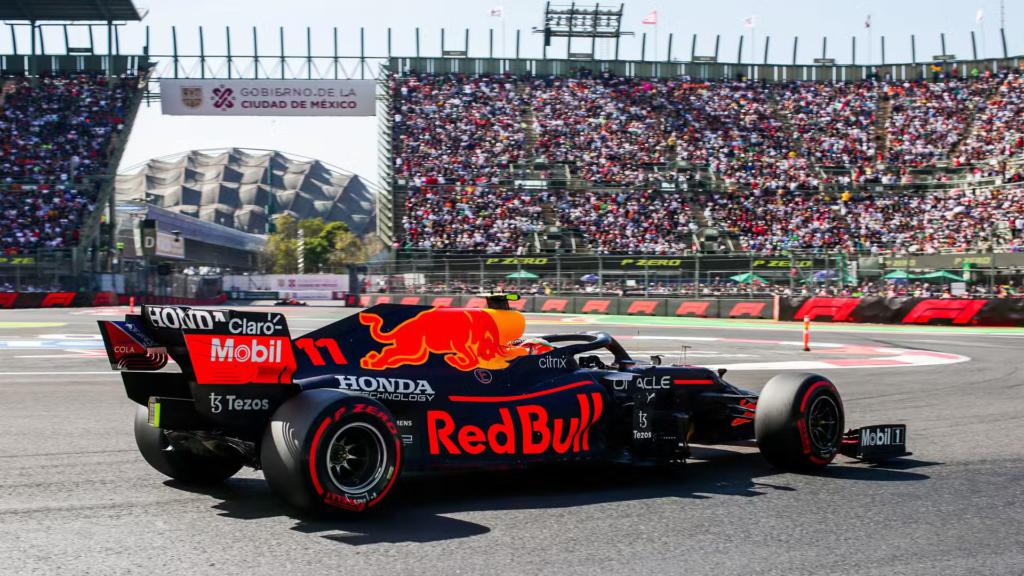Formula 1 Calendar takes us to various locations, and some of them are in unique places. But the F1blast team got curious about what are the 6 F1 tracks with the highest altitude. We’ve taken a look at the highest point of each of the F1 racetracks, and compared it to create the list of highest altitude tracks in F1.
F1 Tracks With Highest Altitude
- Autódromo Hermanos Rodríguez, Mexico – 2232m (7322 ft)
- Interlagos, Brazil – 765m (2509 ft)
- Red Bull Ring, Austria – 700m (2296 ft)
- Las Vegas, USA – 620m (2030 ft)
- Spa Francorchamps, Belgium – 470m (1542 ft)
- Hungaroring, Hungary – 270m (885 ft)
Challenges of Racing at High Altitude
Racing at high altitude is no easy feat for F1 teams and drivers. The thinner air means that cars generate less downforce, which can significantly impact handling and stability. Additionally, the lower air density results in reduced engine power, making it more challenging for drivers to gain speed. The Energy Recovery System (ERS) also faces increased strain at high altitudes, often leading to overheating issues. Moreover, the high altitude can disrupt the combustion process, further diminishing engine performance. All the teams must meticulously plan and adjust their strategies to tackle these challenges effectively when preparing for a high-altitude race.
6. Hungaroring – 270m (885ft)
Hungaroring has been home of the Hungarian Grand Prix since 1986. The venue is located just outside of Budapest, the capital of Hungary, which is a landlocked country – without the sea access. Although the elevation is not outstanding, it made the list of top 6 F1 tracks with highest altitude due to it’s hilly surroundings.
Thanks to the hilly region, Hungaroring has its ups and downs, which makes the flow of the circuit one of the best in the calendar. The reduced air density at higher altitudes affects the airflow through air intakes, leading to overheating challenges for the car’s power units and brakes. Being extremely narrow and twisty, it’s often called “Monaco without barriers”.
5. Spa Francorchamps – 470m (1542ft)
The Spa Francorchamps circuit not only has the biggest elevation difference within one lap, reaching over 100 metres, but is also one of the F1 tracks with highest altitude on the calendar. The highest point on this track is Turn 6, the Les Combes chicane, at the end of the Kemmel straight, which sits at 470m above sea level.
Located in the Ardennes Forest, the Spa Francorchamps feels like a rollercoaster to the F1 drivers. Thanks to the twisty 2nd sector, and the famous Eau Rouge and Radillion section, most of the teams bring their high-downforce rear wings and set up the race for maximum downforce. The weather in Belgium often plays a big role in the race as well, and rain affects the racing.

4. Las Vegas – 620m (2030FT)
Vegas is the newest track on the F1 calendar, and it took the sports by storm. It was the most media-covered F1 event ever, with one of the biggest viewerships in the USA. Although the Las Vegas Grand Prix is a street circuit, Las Vegas itself has quite high elevation. The city is approximately 600 metres above the sea level, and the highest point of Las Vegas Grand Prix is 620 metres above the sea level.
Las Vegas is F1’s newest night race, and the race delivers one of the best photos from the whole F1 season. Although the elevation change is almost insignificant, the fast turns create enough of a challenge to the drivers to make this track very difficult and demanding.
3. Red Bull Ring – 700M (2296 FT)
Red Bull Ring is the track in Austria, surrounded by steep mountains, often exceeding 2000 metres of elevation. The picturesque track has huge elevation changes as well. Within one lap, the drivers change their elevation by 63.5 metres (208 ft). With 71 laps in a race, and 63.5m of elevation change per lap, the drivers change their elevation by a total of 4500 metres within one race! It’s the biggest change, beating the Spa Francorchamps track.
At this height, the air starts becoming thinner, and teams must go for more downforce oriented setups, as well as additional engine cooling.
2. Interlagos – 765m (2509 FT)
The highest point of Interlagos is it’s finish line, with a slight descent towards the turn 1. The race track located in the heart of São Paulo is one of the most beloved races on the F1 calendar, and it’s high elevation (and elevation changes) play a big role. Drivers plunge downhill from the Senna Esses to Juncao, navigating the challenging terrain that impacts car stability and racing strategy. Drivers need to nail their setup, to have enough downforce, yet don’t lack speed on the main straight, as they risk dropping through the order like stones.
Interlagos is very demanding, as the temperatures can reach 35°C on Saturday, with Sun heating up the tyres and overheating the engine, and be hit by a thunderstorm on the next day.
1. Autódromo Hermanos Rodríguez – 2232m (7322 ft)
Autódromo Hermanos Rodríguez, home of the Mexican Grand Prix is the f1 race track with the highest altitude by a mile (literally). The eleveation of 2232 metres above sea level is higher than the summed heights of Las Vegas, Red Bull Ring, Spa Francorchamps and Hungaroring combined! The race track itself is quite flat, and doesn’t have big elevation changes.
At this height, the air is so thin, that engines are struggling to produce max power, and despite the longest distance from straight line to turn 1, all teams bring their extremely high downforce set-ups. Both front wings and rear wings are specifically adjusted, just for this one race, to make the car responsive, and some teams make special holes in the bodywork to improve the engine cooling.

Impact of Less Air on Car Performance
The reduced air density at high altitudes has a profound impact on car performance. With less air available, the cars experience a drop in airflow through the diffuser, reducing the downforce, affecting their handling and stability. This lower air density also translates to reduced engine power, making it harder for drivers to gain speed on the straights. Additionally, braking performance suffers, as the reduced air density means less effective cooling for the brakes. Teams must take these factors into account and make necessary adjustments to the car’s setup to compensate for the reduced air density, ensuring optimal performance during high-altitude races.
Driver Challenges On F1 Tracks With Highest Altitude
High-altitude racing presents several challenges for F1 drivers. The thinner air means cars have less downforce, impacting their handling and stability. The lower air density also leads to reduced engine power, making it more difficult for drivers to gain speed. Beyond the mechanical challenges, drivers face physical hurdles such as increased fatigue and dehydration due to the high altitude. The reduced oxygen levels can also affect their ability to focus and react quickly, increasing the likelihood of mistakes on the track. Drivers must be in peak physical condition and mentally prepared to tackle these unique challenges.
Why Thinner Air at High Altitude Plays a Big Role in F1
The higher the altitude, the thinner is the air, which is one of the biggest factors of an F1 car performance. Air is used to generate downforce, so with the thinner air, the car with the same set up, will generate much more downforce, and will be more difficult to drive.
The same issues occur with drivers trying to cool down their engine and brakes. The thinner the air, the more of it is needed to cool down the main components of an f1 car. At this point, teams have to sacrifice even more performance and downforce, to cool down the power unit and brakes. More holes in the bodywork and the bigger they are, the slower the F1 car will be able to go

